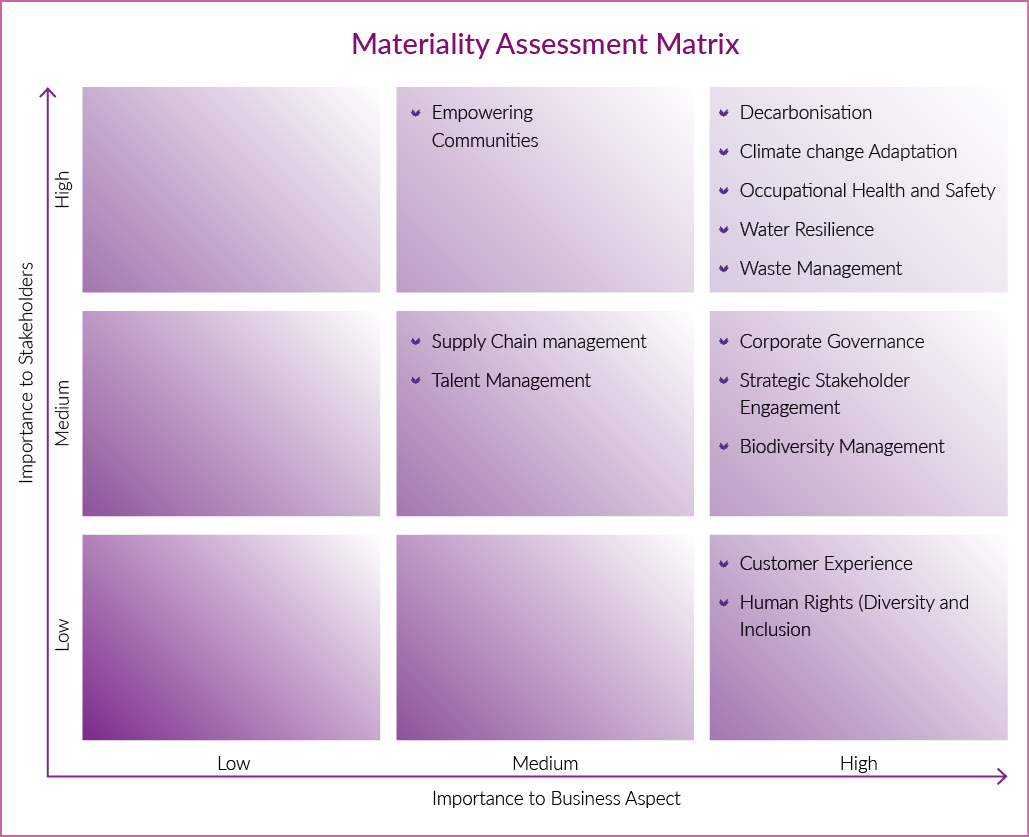Materiality Assessment
In line with our commitment to ESG principles, we have undertaken a comprehensive materiality assessment exercise to identify the key areas of focus for our businesses. This process involved a three-step approach to determine the topics that are material to our operations in the real estate, pulp and paper, and textiles industries.
Process of determination of material topics

Determine the material topic that are pertinent to our Company’s operations.

Prioritise the material topics based on the ratings by the stakeholders through a structured questionnaire.

Prepare a materiality matrix representing significance of material topics to stakeholders and business aspects.
By evaluating the potential impact of various issues, we have identified the material issues that are applicable across all three of our businesses. In this report, we present a detailed overview of these material issues and the measures we have implemented to address them effectively.
The ESG priorities identified through revisiting our material topics have guided our continuous efforts to improve and deliver sustainable outcomes. These priorities were identified based on inputs from a diverse range of stakeholders, including customers, investors, supply chain partners, government and regulatory bodies, employees (including contract employees), and community representatives.
The findings of the materiality exercise have been instrumental in shaping our approach to addressing ESG concerns. They have provided us with a comprehensive understanding of the areas where we can make a meaningful impact and drive positive change. Our ongoing efforts are aligned with these priorities and are aimed at mitigating risks, capturing opportunities, and creating sustainable value for all stakeholders.
The findings of this materiality assessment can be categorised into critical (high priority), progressive (medium priority), and nascent (low priority). These topics are mapped according to the verticals of E, S, and G, along with linkages to relevant SDGs and initiatives taken by CTIL to address these material topics.
We decided to revisit the material topics identified in the previous year's assessment to align our sustainability and business conduct priorities with the current business landscape and operational context. Discussions with the leadership team and extensive research, including analysing peer assessments and trends from ESG indices and frameworks, were conducted during the revisitation process. This ensured that CTIL's materiality assessment remained comprehensive and in line with the latest sustainability priorities and challenges, demonstrating the Company's commitment to sustainable business practices. Upon evaluation, no significant changes in the business landscape or CTIL's operations were identified that would require a revision of the material topics previously identified, reinforcing the Company's consistent and focused approach towards addressing existing sustainability challenges and opportunities as compared to the previous year.
Environmental Material Topics
| Material Topic | GRI Indicators | SDG Alignment | IR Capital Alignment |
|---|---|---|---|
| Decarbonisation | 302 305 |
7, 12, 13, 15 |  |
| Climate Change Adaptation | 201-2 | 11, 13 | |
| Water Resilience | 303 | 6, 12 | |
| Waste Management | 301 306 |
6, 12, 15 | |
| Biodiversity Management | 304 | 6, 15 |
| Social Material Topics | GRI Indicators | SDG Alignment | IR Capital Alignment |
|---|---|---|---|
| Occupational Health and Safety | 402
403 |
3, 8 |  |
| Human Rights (D, E, I) | 405 406 |
5, 10 |  |
| Supply Chain Management | 308 414 |
5, 8 |  |
| Talent Management | 401 404 |
4, 5, 10 |  |
| Customer Experience | 416 417 418 |
3, 9, 12 |  |
| Empowering Communities | 413 | 3, 4, 5, 6, 8, 9, 10 |  |
| Governance Material Topics | GRI Indicators | SDG Alignment | IR Report Mapping |
|---|---|---|---|
| Corporate Governance | 2 | 16 | |
| Strategic Stakeholder Engagement | 2-29 | 16 | SEMA |










